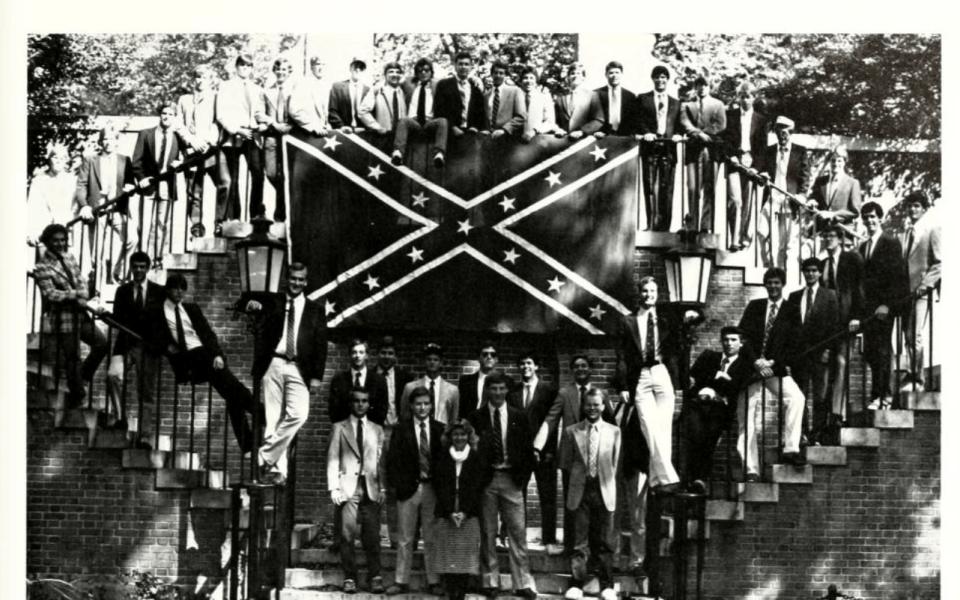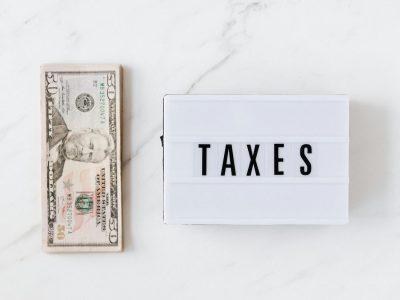As outrage continues to build about Virginia Gov. Ralph Northam’s recently surfaced racist yearbook photo, journalists are scrambling into the archives to see what other horrors are there, just waiting to be dug up. After the News & Observer’s Colin Campbell found an astounding image of frat brothers at UNC dressed as Klansmen stringing up someone in blackface, it seemed likely that Triad schools might have some skeletons in the closet, too.
It’s easy — yet time consuming — to flip through old North Carolina yearbooks using this free
digital archive. But of the Triad’s colleges, one fraternity at Wake Forest University immediately stood out.

If you attended a college with a chapter of the Kappa Alpha Order — especially during the Reagan Era or Civil Rights Movement, it seems — the pages of the Howler yearbook at Wake Forest won’t surprise you. None of the images are as jarring as others being uncovered throughout the country (including one
from the University of Richmond in 1980 similar to the simulated Klan hanging at UNC the year prior, but this time with an actual black student’s neck in the noose). Still, they serve as a testament to the culture
of Wake Forest University’s oldest fraternity, a bastion of Southern white men all too eager to sign up for a Confederate-worshipping brotherhood.
Founded in 1865 — the year the Civil War ended — at what is now Washington & Lee University, the Kappa Alpha Order has always looked to Confederate General Robert E. Lee as its “spiritual founder.” Lee, then the president of the college, served as a symbol of the kind of man Kappa Alpha members aspired to be, citing his “religious convictions, exemplary ideals, values, strong leadership, courtesy, respect for others and gentlemanly conduct.” A few years later in 1881, students established the fraternity at what was then Wake Forest Institute.

Though early Wake Forest yearbooks remained relatively muted, it’s clear from the fraternity’s pages in the mid-20th Century that Kappa Alpha retained its deep obsession with Lee and the Confederacy. In 1956, the year the college relocated to Winston-Salem, they posed “proudly” with an antique portrait of Lee they’d just acquired. The likeness would go on to appear in the background of numerous yearbook photos in the future. Images on the frat’s pages in 1957 and 1959 show Confederate flags adorning walls, and a 1960 photo reveals a podium with the label: “Hotel Robert E. Lee.” That same year in neighboring Greensboro, gangs of white boys around the same age would rally to — and weaponize — the Confederate flag as they harassed sit-in demonstrators, as they did throughout the South that decade, holding up the flag as a symbol of segregation.

In 1963, when Martin Luther King Jr. spoke at Wake Forest, the KA brothers all had a picture of the Confederate general in their rooms, according to the yearbook. Under a photo of a frat brother talking on a rotary phone, the caption reads: “At the KA House, Alexander Graham Bell’s invention holds almost as prominent a place as the portrait of Robert E. Lee.”

The 1969 yearbook also states that Lee’s portrait “hangs in every brother’s room,” underscoring the frat’s fixation. The language on the group’s page that year speaks for itself, in many ways: “The Kappa Alpha fraternity epitomizes what orientals mean when they talk about ancestor worship and reverence for the past,” it begins. “General Robert E. Lee symbolizes all that is good in the long-lost tradition of Southern chivalry.”

But it isn’t just that the KAs ascribed to a whitewashed mythology of the South. As the same 1969 yearbook page cryptically states: “In response to other campus goings on this year, some of the brothers staged an anti-demonstration for the preservation of the stars and bars.”
“As the brothers initiated sixteen neophytes into their esoteric mysteries,” it continues, “it seems that the Lee cult, strongly based in ancient tradition, was far from being stifled.”
On the same page, a Confederate flag hangs outside a window, and the caption reads: “KA: The stars and bars forever!”
It wasn’t just the Civil Rights Era that saw a blossoming of statements like “Robert E. Lee would be proud of these worshippers of the past,” or “R.E. Lee lives: in the KA House,” (both in 1968). After a relatively
quiet decade in the ’70s, Kappa Alpha came roaring back in the Reagan Era.

The 1981 edition of the Howler introduces the frat in its opening to the “Greek” section thusly: “If the Confederate flags leave you confused, strains of, ‘3, 2, 1, South should’ve won,’ tell you you’re passing the Order of Kappa Alpha.”
-

Beer and bayonets: The boys of KA celebrated their “beer slide” and the Confederacy in 1981.
That year, like many others, yearbook viewers can see the KAs participating in their ritualistic game of dress-up as Confederate soldiers. Though previous photos showed fraternity brothers posturing more
seriously in Confederate costume, by 1981 they appear to be drinking while posing with a rabbit mask in front of the stars and bars.
The so-called “fraternity of the South” not only held an annual Robert E. Lee Banquet, but also frequently organized events in Lee’s honor and held an “Old South Ball,” part of a weeklong celebration often held
in nearby cities. Nationally, these KA parties were typically held on plantations according to one news report, and were inspired by the iconography of Gone With the Wind. Frat brothers donned gray Confederate soldier uniforms, and women in hoop skirts would come along for the white supremacist make-believe.

In 1964, the Wake Forest KA chapter’s drill team “won the top honors” at the ball held in Asheville. In the yearbook photo, they look more like a military reenactment regiment than the drunk hooligans of ’81. Yet
just a little more than a year after the Greensboro Massacre carried out by a Klan-Nazi alliance that also sported a Confederate flag, the frat’s casual Confederacy isn’t exactly comforting.

By 1982, the Wake Forest Kappa Alphas leaned hard into the Confederate schtick. In their group photo, they ditched the fraternity flag, replacing it with a massive treasonous battle flag that’s as wide as nine of
them standing abreast. It remains in the group photo for the next 3 years, disappearing in 1986 before resurging in 1987.
Some of the pages from those years offer additional insight. In 1983, with no apparent sense of irony, they included a photo of a “FLESH-PILE!” of frat brothers sprawled on each other like middle-schoolers at a sleepover next to the sober text: “Kappa Alpha Order, comprising young men of noble birth destined for chivalry, is Southern in a significant sense wherein its essential teachings are for its members to cherish the ideal of character, and attributes of the true gentleman, of which Robert E. Lee was the near
perfect expression.” Below the “flesh pile” and descriptive text, there’s another photo of Confederate dress-up, something KA members around the country could still be found doing for their Old South week in the 21st Century.

In 1985, the frat’s page refers to the brothers as “those good ‘ole Southern boys,” and includes a photo of two members smiling behind beer taps, with a small portrait of Lee and an adjacent Confederate flag hung behind them.
The Wake Forest chapter of the frat kept up their charades after Reagan’s second term expired. Though Confederate flags dropped out of the yearbook at the tail end of the 1980s, the 1990 yearbook explains that at the Old South Ball every spring, “the brothers dress in Confederate uniforms while their dates dress as Southern belles,” which it says is “keeping with the Southern tradition.” The next year, the frat’s page still refers to Lee as its “spiritual founder,” but the whole Confederate thing appears to have fallen out of style in the Clinton years, at least as far as the yearbook is concerned.

As a national fraternity, Kappa Alpha has distanced itself from some of this overt past. In 2001, the group banned all visual displays of “the Confederate Battle Flag,” including from chapter buildings, member clothing, and websites. Apparently in 2010, they felt the need to clarify, explicitly barring Confederate uniforms or participation in a parade where Confederate uniforms are worn. In 2016, the national organization blocked chapters from using “Old South” terminology, as they had for decades. The fraternity’s website still explains its ties to Lee and calls him their spiritual founder, but it explicitly avoids any mention of his role in the Confederacy or Confederate Army, skipping to after the Civil War.

But that whitewash job doesn’t mean the frat has been able to avoid controversy. At Wake Forest, for example, the Kappa Alphas came under fire in 2014 for their racist annual “Rap Video Party,” where white frat members and guests allegedly aimed to “dress like a Black person.”
The KAs aren’t the only Wake Forest University frat to include racially incendiary material on their pages of the Howler —an image on the 1976 page of Sigma Pi fraternity appears to show someone in costume as a Klansman. On a page in the 1968 yearbook, someone waves the stars and bars in front of a massive crowd of white faces, though the picture lacks a caption or any additional context for who is doing the waving, or why.

It’s possible that a closer review of the Howler from the last 60 years would reveal additional cringe-worthy and infuriating content, but it’s clear that for decades — hell, more than a century — the Kappa Alpha Order wanted the mantle of the “Old South” to rest on their shoulders.
The story isn’t unique to Wake Forest University, of course. Instead, the KAs are a microcosm of a much larger trend. The pages of the yearbook make them look more like an outlier than the norm, yet it’s clear that, to some extent, they influenced the culture of the school. Just look at the 1982 full-page spread, asking “Are You a Greek?” which includes a small Confederate flag taped to a frat bro’s chest and the caption: “1, 2, 3, Robert E. Lee…”

There is another local chapter of Kappa Alpha, this one at High Point University, but it didn’t form until 2014, according to the school’s website. A quick perusal of yearbooks from other Triad colleges paints a less inflammatory picture. Politics still found their way in, but in a different format. In the 1980 yearbook for Greensboro College, for example, there are photos of “a pro-American rally” (presumably related to the Iran Hostage Crisis taking place that academic year) as well as shots of Julian Bond and Bobby Kennedy Jr. on campus. But explicit signs of the Confederacy and white nationalism are nowhere to be found, and they also aren’t as readily available on other campuses as Kappa Alpha made them at Wake.
Eric Ginsburg is the former managing editor of Triad City Beat, and now works as an independent journalist.
Join the First Amendment Society, a membership that goes directly to funding TCB‘s newsroom.
We believe that reporting can save the world.
The TCB First Amendment Society recognizes the vital role of a free, unfettered press with a bundling of local experiences designed to build community, and unique engagements with our newsroom that will help you understand, and shape, local journalism’s critical role in uplifting the people in our cities.
All revenue goes directly into the newsroom as reporters’ salaries and freelance commissions.





Leave a Reply